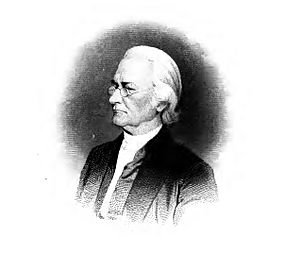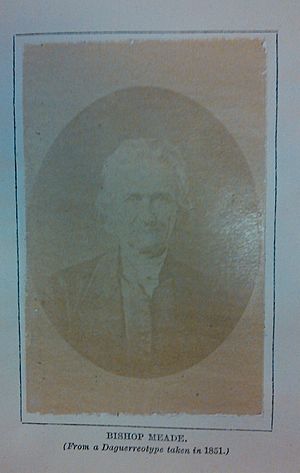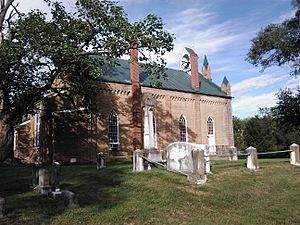William Meade facts for kids
Quick facts for kids William Meade |
|
|---|---|
| Bishop of Virginia | |
 |
|
| Church | Episcopal Church |
| Diocese | Virginia |
| In Office | 1841–1862 |
| Predecessor | Richard Channing Moore |
| Successor | John Johns |
| Orders | |
| Ordination | January 29, 1814 |
| Consecration | August 19, 1829 by William White |
| Personal details | |
| Born | November 11, 1789 White Post, Virginia, United States |
| Died | March 14, 1862 (aged 72) Richmond, Virginia, United States |
| Buried | Virginia Theological Seminary, Alexandria, Virginia |
| Nationality | American |
| Denomination | Anglican |
| Previous post | Assistant Bishop of Virginia (1829–1841) |
William Meade (November 11, 1789 – March 14, 1862) was an important American Episcopal bishop. He served as the third Bishop of Virginia.
Contents
Early Life and Education
William Meade was born on November 11, 1789, in White Post, Virginia. His family lived on a plantation called 'Meadea'. Later, they moved to another plantation called Lucky Hit. Both of these homes are now listed on the National Register of Historic Places.
His father, Colonel Richard Kidder Meade, was an aide to George Washington during the American Revolutionary War. After the war, his father moved the family to the Shenandoah Valley.
William Meade was taught at home until he was ten years old. Then, he went to a school run by Rev. Wiley. Instead of attending the College of William and Mary in Virginia, he chose to go to the College of New Jersey (now Princeton University) in 1806. He graduated with high honors in 1808.
After college, Meade studied theology (the study of religious faith) privately. He was very impressed by books like Internal Evidence of Christianity and Practical View. He also returned to Princeton for more studies but got very sick. He then went home to work on his family's farm. He also built his own home called Mountain View.
Family and Personal Life
William Meade came from a family with a long history in Virginia. His great-grandfather, Andrew Meade, was one of the first family members to come to America.
William Meade married Mary Nelson in 1810. They had three sons together. Mary passed away in 1817. Three years later, in 1820, William Meade married Thomasia Nelson. She was very supportive of his church work for twenty years until she died in 1836. One of Bishop Meade's sons, Richard Kidder Meade, also became a clergyman.
Becoming a Church Leader
William Meade became a deacon in the church on February 24, 1811. At that time, the Episcopal Church in Virginia was struggling. After the American Revolution, the church had lost many ministers.
Meade and other church leaders worked hard to rebuild the church. They helped convince William Holland Wilmer to become a rector in Alexandria. They also helped bring Richard Channing Moore to Richmond, who later became the Bishop of Virginia. Meade was ordained as a priest in 1814.
From 1811 to 1821, Meade served as an assistant minister at Frederick Parish. He often led services at the Old Chapel near his home. On other Sundays, he would visit different churches.
Meade believed that church leaders should also work with their hands. He worked on his farm and taught his sons and nephew about both schoolwork and manual labor. He was known for traveling all over Virginia, often by horse, to preach to different church groups.
In 1818, Meade helped start an education society in Alexandria. Later, he helped create the Virginia Theological Seminary in Alexandria in 1823. This seminary trained young men to become ministers. From 1842 to 1862, Bishop Meade was the seminary's president. He also helped found the Evangelical Knowledge Society in 1847. This group published books that supported their evangelical Christian beliefs.
Bishop of Virginia
In 1829, William Meade became the assistant Bishop of the Episcopal Diocese of Virginia. He was consecrated (officially made a bishop) in Philadelphia.
His first official act as assistant bishop was to dedicate a new church building in Winchester. He then began visiting churches all over Virginia. He traveled through the Shenandoah Valley and even across the Appalachian mountains to Kentucky and Tennessee. In 1841, he visited London, England.
When Bishop Moore died in 1841, Meade became the Bishop of Virginia. He then consecrated John Johns as his assistant. Under Bishop Meade's leadership, the number of clergy (ministers) and church members in Virginia grew significantly.
Bishop Meade was a "low Churchman," meaning he focused on evangelism and missionary work. He preached about the teachings of Jesus Christ. He was against the Oxford Movement, which he felt was too similar to the Roman Catholic Church. He believed in salvation through God's grace. Bishop Meade was also involved in church cases against other bishops who he felt were not following church rules.
In 1851, some parts of Virginia wanted to form their own church diocese. Bishop Meade pointed out that they did not have enough ministers to do so, and the idea was put on hold until after his death.
Views on Slavery
William Meade freed his own slaves. They moved to Pennsylvania because Virginia laws at the time did not allow freed slaves to stay in the state without special permission. His views were shaped by his sister and his mentors, who also freed slaves.
In 1816, Meade helped create the American Colonization Society (ACS). This group aimed to help free African Americans move to Africa. Meade traveled through the American South to promote the ACS.
However, Meade did not see slavery itself as a sin. He thought it was more of an economic problem. He believed that Christian teachings could help masters treat their slaves well. In 1813, he published a collection of writings that supported slavery from a Christian viewpoint. After becoming a bishop, he wrote about the importance of religious instruction for slaves.
From 1833, Bishop Meade, along with Judge William Leigh and lawyer Francis Scott Key, worked to carry out the will of their friend John Randolph of Roanoke. Randolph's will stated that his more than 400 slaves should be freed. The executors fought for ten years in court to make sure this happened and that the freed slaves received land.
In 1841, Meade urged ministers to preach to slaves or hold special services for them. He also suggested that if resources were limited, they should focus on teaching slave children. As he got older, his views on slavery became more traditional.
A Leader During the Civil War
Bishop Meade tried to prevent Virginia from leaving the United States before the American Civil War. He preached against the war in June 1861. However, he believed in states' rights and accepted Virginia's decision to secede.
Even though he was close to retirement, Bishop Meade became a key figure in the Protestant Episcopal Church in the Confederate States of America. In 1861, he led a meeting in South Carolina that helped create the new Confederate Episcopal Church.
On March 6, 1862, Bishop Meade traveled to Richmond, Virginia, even though he was very ill. He helped consecrate Richard Hooker Wilmer as the bishop of Alabama. Bishop Meade died a few days later. It is said that he gave his last blessing to Confederate General Robert E. Lee, whom he had known for a long time.
Death and Legacy
Bishop William Meade died in Richmond, Virginia, on March 14, 1862, at the age of 72. He was buried in Hollywood Cemetery, but his remains were later moved to the Virginia Theological Seminary in Alexandria.
After Meade's death, some counties near his home became part of the new state of West Virginia. The Episcopal Diocese of West Virginia was formed in 1877. Its first bishop, George William Peterkin, had been encouraged by Bishop Meade.
In 1868, a church was authorized near the Meade family's estates in White Post. It was completed in 1875 and is now called Meade Memorial Church. It still has an active congregation today. In 1870, another church was named in his honor, Meade Memorial Church in Alexandria. This church was created for African American Episcopalians and is still active.
See also



